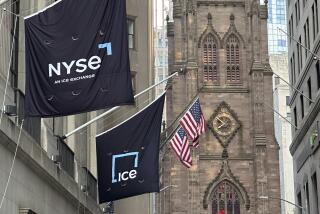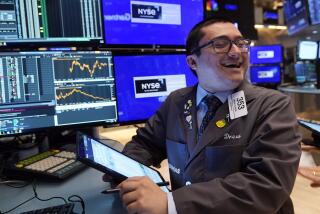For Stocks, Reaching a Bottom Is a Process
Wall Street desperately wants to believe that the stock market has bottomed.
But the market, as is often the case, seems to have other ideas--starting with the already-crushed technology sector.
Some analysts say a critical issue for many tech stocks now is “overhead supply”: Some companies have so many billions of shares outstanding that the selling pressure may remain enormous whether the stocks fall further or attempt to rally.
Share prices in general plunged anew late last week, taking back a hefty chunk of the gains racked up in the rally that followed the five-year lows reached July 23.
Blame for the latest sell-off, however, was pinned not on the growing ranks of alleged corporate felons but on a more traditional suspect: the economy.
The government’s report Friday that the economy created a net 6,000 new jobs in July, far below expectations, fanned worries of a “double dip”--another recession hard on the heels of last year’s downturn.
That would be trouble enough for many companies. But the action in the market late last week suggested that the prospect of a second recession would be particularly devastating for the tech sector, where trillions of dollars in market value already have been obliterated since prices peaked in March 2000.
The blue-chip Standard & Poor’s 500 index fell 4.3% from Tuesday’s close through Friday, when it finished at 864.24--still 8.3% above its five-year closing low of 797.70 reached July 23.
Meanwhile, a number of tech stock indexes on Friday fell through their July lows to their worst levels since at least the late 1990s. They included the Goldman Sachs software stocks index, the SOX semiconductor index and the Interactive Week Internet index.
The Nasdaq 100, which includes the biggest tech stocks in that market, closed at a five-year low of 892.51 on Friday, skidding through the July 23 close of 896.82. The index had jumped 9.3% between July 23 and last Tuesday, raising hopes that the 29-month-old bear market had finally been vanquished.
John Bollinger, who writes the Capital Growth Letter investment report from Manhattan Beach, said last week that the classic chart formation of market bottoms since World War II has been a W--meaning that market indexes typically hit an initial low, rally for a time thereafter, then fall back to levels either close to the initial low or under it.
Usually, only after that second low, or series of lows, can a new bull market begin, Bollinger said.
But second and final lows in these W-formations generally don’t occur quickly after the initial low, he said. On average since 1949, final bottoms have been reached 10 to 15 weeks after the initial low.
If July 23 marked the initial low for most stocks in this bear market--something that will be evident only in retrospect, of course--prices may now be in a bottoming process that could last into October, Bollinger said.
The point being, he said, that investors should be prepared for more pain, and that long-term bargain hunters must accept that stocks they buy now could get even cheaper before they hit their absolute lows.
The positive view of this bottoming process is that investors who are looking to buy shouldn’t feel rushed, Bollinger noted.
At the same time, some companies in the beaten-down tech sector may face a special problem regardless of whether the market goes lower or higher from here.
Companies including Oracle Corp., Sun Microsystems Inc., Cisco Systems Inc. and AOL Time Warner Inc. have literally billions of shares outstanding, the legacy of the tech sector’s boom years in the 1990s.
Oracle, for example, has 5.5 billion shares in the market. That’s more than blue-chip giants such as Wal-Mart Stores Inc. (4.4 billion outstanding) and Coca-Cola Co. (2.5 billion).
There is no way to know the average share price paid by Oracle’s current investors. But with the stock at $9.41 on Friday, compared with the peak of $46 in 2000, it’s a reasonable assumption that many of the company’s buy-and-hold investors are far under water.
Many investors who bought the shares in recent months, however, still may have a paper profit: The stock fell as low as $7.32 on June 3, and rallied as high as $10.47 by July 17.
If the stock continues to lose ground in the near term, more investors who bought recently may be tempted to sell, to escape with at least some gain.
Longer-term, if the stock continues to rise, more investors who bought before this year may be tempted to exit as they get closer to even.
This is an issue for the market overall, not just for the tech giants; it’s the reason many analysts believe stocks in general face a slow recovery in the next few years.
But the sheer number of shares outstanding from the big tech companies--the “overhead supply”--raises the risk of greater selling pressure, either way they go.
That doesn’t mean these stocks can’t eventually rebound significantly, if the companies’ fundamentals improve accordingly. “But when you have that kind of supply ... it tends to make it more difficult,” said Tim Hayes, senior equity strategist at investment data firm Ned Davis Research in Nokomis, Fla.
After the “Nifty Fifty” blue-chip stocks crashed in 1973-74, the recovery time for some of those stocks was measured in years, not in months, Bollinger said. And for some, he noted, there was no recovery.
*
Tom Petruno can be reached at [email protected]. For recent columns on the Web, go to: www.latimes.com/petruno.
*
(BEGIN TEXT OF INFOBOX)
Billionaires
How shares outstanding from major tech companies compare with some non-tech blue-chip firms:
Outstanding Company shares (blns.)
General Electric 9.9
Cisco Systems 7.3
Intel 6.7
Oracle 5.5
Microsoft 5.4
AOL Time Warner 4.4
Wal-Mart 4.4
Nortel Networks 3.7
Lucent Technologies 3.4
Sun Microsystems 3.2
Johnson & Johnson 3.0
Coca-Cola 2.5
Philip Morris 2.1
Source: Standard & Poor’s
More to Read
Inside the business of entertainment
The Wide Shot brings you news, analysis and insights on everything from streaming wars to production — and what it all means for the future.
You may occasionally receive promotional content from the Los Angeles Times.










